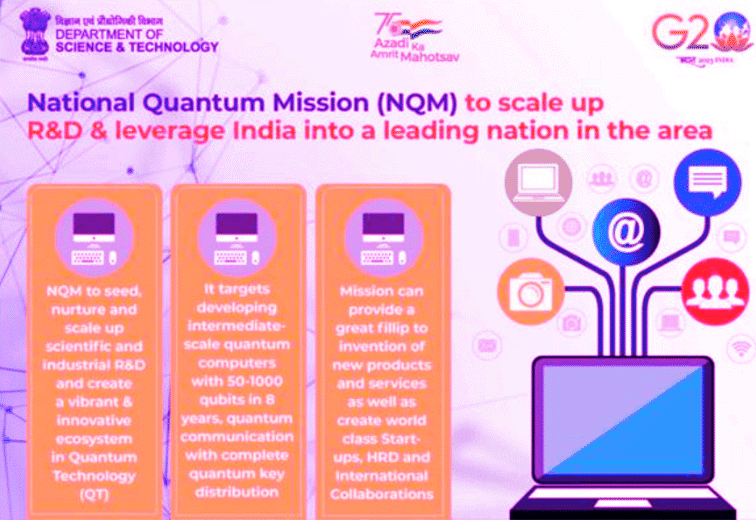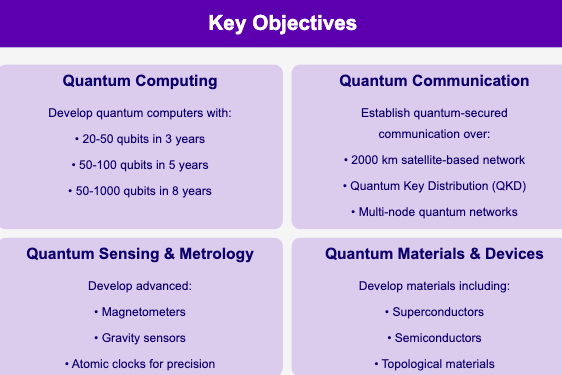PIB Summary- 18th March, 2025 | PIB (Press Information Bureau) Summary - UPSC PDF Download
National Quantum Mission: India’s Quantum Leap
Context
India is advancing in quantum technology with the National Quantum Mission (NQM), approved on April 19, 2023, for a duration of 2023–24 to 2030–31.The mission has a budget of ₹6,003.65 crore and aims to make India a leader in quantum technology research and development.

What is Quantum Computing?
- Quantum computers use qubits instead of regular bits, allowing them to be in multiple states at once (0 and 1 simultaneously).
- This ability makes quantum computing significantly more powerful than traditional computing.
- NQM aims to leverage quantum technology to impact healthcare, clean energy, climate change, and job creation.
Objectives of NQM

Implementation Strategy: Thematic Hubs (T-Hubs)
- Four T-Hubs have been established across India, involving 14 Technical Groups, 17 states, and 2 Union Territories.
- These hubs drive technology innovation, skill development, entrepreneurship, and industry partnerships.
- They follow a Hub-Spoke-Spike model, which enhances collaboration among research institutions.
Global Impact and Strategic Importance
- NQM will help India compete globally in quantum technology.
- It will benefit sectors like telecommunications, healthcare, finance, and energy.
- The mission aligns with national initiatives like Digital India, Make in India, Start-up India, and Sustainable Development Goals (SDGs).
Conclusion
- The National Quantum Mission is a transformative step toward making India a leader in quantum technology.
- With significant investments and research collaborations, it will drive innovation, economic growth, and national security.
- NQM ensures India is prepared for the quantum future, securing its position in the evolving global technological landscape.
Carbon Emissions in Mining Operations
Context
India’s Ministry of Coal is actively promoting sustainable coal mining practices to reduce carbon footprints and align with global and national climate goals. The initiatives focus on environmental reclamation, energy efficiency, mechanization, renewable energy adoption, and compliance with environmental regulations.
Greening Initiatives – Bio-Reclamation & Plantation
- Coal/Lignite PSUs (Public Sector Undertakings) are engaged in afforestation and land reclamation in and around mining areas.
- Efforts are aimed at reducing the environmental impact of coal extraction by restoring mined-out land.
- This contributes to carbon sequestration, biodiversity conservation, and ecosystem restoration.
Energy Efficiency Measures
- Coal/Lignite PSUs are implementing multiple energy conservation strategies to reduce carbon intensity:
- Lighting: Replacement of conventional bulbs with LED lights to reduce electricity consumption.
- Cooling & Ventilation: Installation of energy-efficient air conditioners, super fans, and efficient water heaters.
- Electrification: Deployment of electric vehicles (EVs) in mining areas to reduce diesel dependence.
- Pumping & Street Lighting: Use of energy-efficient motors for pumps, auto-timers for streetlights, and smart grid integration.
- These measures collectively enhance operational efficiency and reduce emissions from coal mining operations.
Green Credit Programme
- Coal PSUs are participating in the Green Credit Programme launched by the Ministry of Environment, Forest, and Climate Change (MoEF&CC).
- Encourages afforestation efforts by linking them to carbon credit mechanisms.
- Provides incentives for sustainable land use and tree plantation in mining areas.
First Mile Connectivity (FMC) Projects
- FMC projects aim to modernize and mechanize coal transportation from mines to dispatch points.
- Key benefits include:
- Reduction in diesel-based transport, thereby lowering carbon emissions.
- Increased reliance on conveyors, silos, and railway sidings for coal movement.
- Minimization of air pollution caused by road-based coal transportation.
- These projects contribute to achieving low-carbon logistics and cleaner supply chains.
Deployment of Blast-Free Technology in Coal Mining
- Traditional coal mining involves drilling, blasting, and crushing, leading to dust, noise, and air pollution.
- To address this, Coal PSUs are adopting modern mining equipment with eco-friendly features:
- Surface Miner & Continuous Miner: Eliminates the need for blasting and reduces dust emissions.
- Highwall Mining & Longwall Mining: Enables extraction with minimal surface disruption.
- Ripplers: Used for overburden removal without blasting, reducing environmental hazards.
- These technologies enhance worker safety while minimizing ecological disturbances.
Renewable Energy & Clean Coal Initiatives
- Coal PSUs are diversifying energy production by integrating renewable energy projects:
- Solar power plants in de-coaled areas.
- Wind energy projects in coal belt regions.
- Clean coal technologies being promoted include:
- Coal Gasification: Converts coal into syngas for cleaner industrial use.
- Coal Bed Methane (CBM) Extraction: Harnesses methane trapped in coal seams to reduce greenhouse gas (GHG) emissions.
- These initiatives align with India’s transition towards low-emission coal utilization.
Environmental Compliance & Carbon Footprint Reduction
- Sustainable coal production is ensured through strict adherence to environmental regulations:
- Environmental Clearance (EC) & Forest Clearance (FC) for new mining projects.
- Consent to Operate (CTO) & Consent to Establish (CTE) from pollution control boards.
- Steps taken to mitigate environmental impact:
- Use of Surface Miners, Continuous Miners, and Highwall Mining to minimize land degradation.
- Expansion of First Mile Connectivity (FMC) to reduce emissions from coal transport.
- Rehabilitation of mined-out lands through reclamation, eco-restoration, and afforestation.
- Mine Tourism & Eco-Parks: Promoting sustainable reuse of mined-out lands for ecological and community benefits.
- Repurposing of de-coaled areas for renewable energy installations and agriculture.
Gaps & Challenges in Environmental Monitoring
- Lack of specific guidelines for reviewing Environmental Impact Assessment (EIA) reports with respect to carbon emissions.
- No mandatory frequency set for coal companies to assess their carbon footprint and update mitigation strategies.
- Need for continuous monitoring and independent audits to evaluate emission reduction progress.
Conclusion
- The Ministry of Coal’s initiatives reflect India’s commitment to sustainable coal mining while balancing energy security and environmental responsibility.
- However, more structured guidelines for carbon footprint assessment and impact monitoring are required.
- Expanding green coal technologies and strict enforcement of compliance measures will be crucial in achieving India’s Panchamrit & NDC goals.
FAQs on PIB Summary- 18th March, 2025 - PIB (Press Information Bureau) Summary - UPSC
| 1. What is the National Quantum Mission in India? |  |
| 2. How does the National Quantum Mission contribute to India's technological advancement? |  |
| 3. What measures are being taken to reduce carbon emissions in mining operations? |  |
| 4. Why is it important to address carbon emissions in mining operations? |  |
| 5. How do quantum technologies and carbon emission reductions intersect? |  |





















